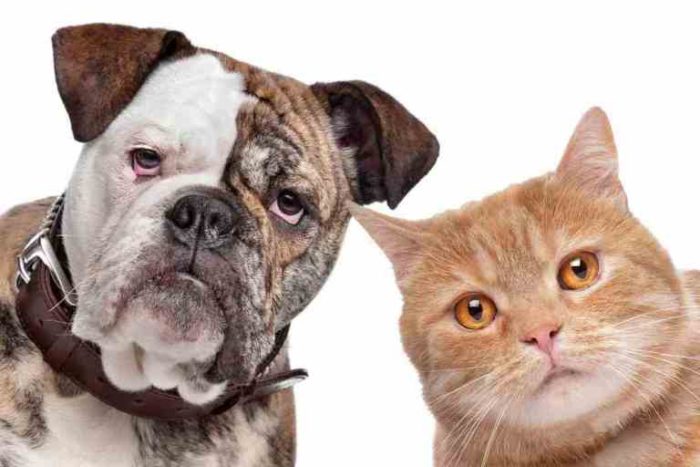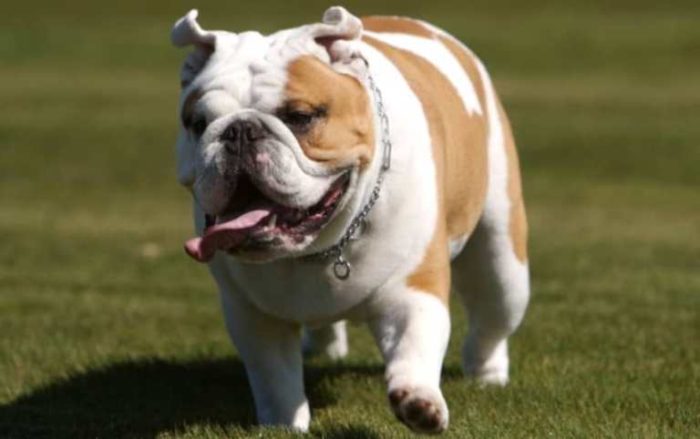Originally, the English Bulldog, simply known as Bulldog, was extensively used in the livestock field, driving cattle and taking part in a bloody sport known as bull baiting. Subsequently, with the eradication of bull-baiting, the dog’s temperament was toned down to create what we know to be the amiably tempered Bulldogs that are used as family pets. In fact, the dog is one of the most popular canine breeds worldwide and it may interest you to know that dog food was specifically made for Bulldogs.
Table of Contents
History Of The English Bulldog
Bulldog, as we know, is distinct from their ancestors which were descendants of ancient mastiff-type pups. Developed in England, the breed first earned a mention in 1500 – a description of a guy “with a couple of Bolddogges at his tayle. Then, the fierce-looking canines were employed in a practice known as bull baiting – this involved dogs roughly shaking a bull’s nose after grabbing onto it. After bull-baiting was outlawed in England in 1835, many believed that the Bulldog which wasn’t anywhere near affectionate would go into extinction.
Despite these beliefs, there were still many who admired the breed’s strength, stamina, and affection. These people went ahead to breed the dog into a gentle and sweet-tempered breed while saving its fierce appearance. The canine started appearing in England’s confirmation shows in 1859. Subsequently, Bulldog breed clubs started springing up in England – the first was formed in 1864 with the second coming up in 1875.
Bulldogs later came into America and were first shown in 1880, the American Kennel Club registered the breed in 1886 and gave it full recognition in 1890. Also, The Bulldog Club of America was founded by H.D. Kendall of Lowell, Massachusetts in 1890.
Facts You Need To Know About The English Bulldog
Health
In the same way as all breeds of canines, the Bulldog breed is susceptible to certain health conditions. However, not all members of the breed are likely to get any or all the ailments. But then, it is of utmost importance that pet parents and potential pet parents get informed about these diseases so as to be in a better position to handle them when they eventually occur.
Some of the health issues to look out for in an English Bulldog breed include cherry eye, dry eye, entropion, inverted or reverse sneezing, brachycephalic syndrome, head shakes, demodectic mange or demodicosis, hip dysplasia, tail problems, patellar luxation, or slipped stifles.
Physical Appearance
The Bulldog’s large spherical head with an extremely short muzzle gives it a flattened appearance in the face. The eyes which are set low are dark. The nose is slightly upturned and black in color; the jaws which are also called chops are massive, broad, as well as undershot. The dog’s comical grin is caused by the lower jaw that juts out in front of its upper jaw to barely expose the lower incisors amid the fleshy and pendulous lips. Other facial features of the breed include well-rounded ears, protruding sideways, small thin ears angling forward like flaps framing the forehead.
Its thick and short neck balances on .muscular, massive, and broad shoulders. With a full, deep chest and a slightly arched barreled back, the dog’s rounded hip slightly protrudes above its back level. Straight or screwed, the Bulldog’s tail is stubby and thick. The limbs are short and stocky with great muscle definition, far from straight; they are not only splayed out but slightly bowed at the dog’s elbows and hocks, forming a sturdy, base-wide stance.
The Bulldog breed generally stands 16 inches tall or thereabouts and while the female weighs about 23 kilograms or 50 pounds, the males can be up to 24 kilograms or 54 pounds. The straight short coat of the dog can come in a fine texture, glossy, or smooth with such colors as white, piebald, brindle, red, and fawn. It’s is not rare for all English Bulldogs to come with a spotted coat, with a plethora of colors all at the same time. The skin on its head, neck, and shoulders is loose with heavy wrinkles evident on the head. From the jaw down to the chest are a couple of loose folds, forming what is known as a dewlap.
Feeding
Since Bulldogs are known to be greedy eaters, they are prone to obesity, thus, free-feeding should be avoided. However, their food ration should consist of two meals per day, one in the morning and one in the evening. Again, the total intake of any dog depends on its size, age, activity level, metabolism level, and so on, thus, all these have to be considered before deciding on the quantity of food to shake into the dog’s bowl. On the other hand, quality is not negotiable as the more the quality the better your pup will be nourished and the happier it will be.
Temperament
Unlike the bull-baiting Bulldogs of ancient times, the present-day Bulldogs come with a gentle and sweet disposition. They are predictable, dependable, and people-oriented. A matured Bulldog can be very lazy and may show little enthusiasm about going out for walks. Being loud breathers, the pup tends to wheeze, snore, and drool. The breed is known to have a slightly high prey drive, thus, you have to closely monitor its interaction with other pets.
Important to mention that the Bulldog still retained some of the courage from their bull-baiting days; this makes them excellent watchdogs. Though they will get along in a multi-pet home, given the right socialization, the dog is aggressive and hostile to strange dogs. They can be highly independent, stubborn, and hard to train, and when bored, your English Bulldog will find an escape route.
Grooming
Being a short-coated dog, the English Bulldog requires minimal grooming. However, pet parents should guard against skin infection by wiping or washing the face folds regularly; always dry out the folds after each wash. A soothing ointment can be used when the inside of the wrinkles has signs of redness or irritation. The dog’s nose also requires washing after which petroleum jelly is applied; this saves it from becoming flaky and dry, and at the same time keeps it soft. Since the Bulldog is an average shedder, a firm bristle brush can be used to give its coat a thorough brushing once a week.
Dental hygiene is compulsory with dogs as it reduces the risk of periodontal disease; this can be done daily if not weekly. Nail trimming should be done once or twice monthly depending on how fast they grow. The ears should be equally cleaned when dirty.
Exercise
Bulldogs are lazy by nature, thus, the dog’s speed may just entail a walk followed by a nap on its favorite sofa. Because of this, the breed doesn’t require too much exercise, but a game wouldn’t be a bad idea for your pooch. Some of them have proved to be quite apt in games like agility stuff and flyball.
Training
Though the Bulldog is considered to be a smart breed, it is rather challenging to train. They don’t follow commands at all as they have their own mind and prefer to think for themselves, as a result of this, even the easiest tricks are too difficult for them to learn, However, this can be circumvented by early socialization and obedient training.
Read Also: Boston Bulldog: Breed Information And 6 Important Facts
They Make Great Family Dogs
Novice pet owners can cope well with an English Bulldog as the breed is low maintenance. Its affectionate nature makes it thrive in a family setting and the pup doesn’t take long to adapt to apartment life. Being a people-oriented dog, the Bulldog will actively solicit human attention wherever it is. The pup loves to be part of a family setting and always protects its own.
The English Bulldog Among Children And Other Pets
Any dog with an amiable temperament is considered good for households with children and the same can be said for the English Bulldog. Despite its bulk, the canine is considered to be an excellent companion for kids, including younger ones. A Bulldog is so patient with children and is ready to put up with their accompanying troubles, and instead of retaliating when he gets tired of their troubles, the pup will simply stand back and walk away.
However, parents should try teaching their kids how to interact with dogs, no pulling of ear and tail, no approaching the dog when asleep, eating, and no attempt should be made towards depriving an eating dog of its food. Even with all the placid nature of the Bulldog, recommendations are that no dog should be left unsupervised with kids.
A Bulldog Can Be Reared In A Multi-pet Home

Giving the right socialization and proper introductions, a Bulldog is supposed to peacefully cohabit with other dogs in a multi-pet home. It can also get along with cats if they have been properly introduced. However, the dog tends to display aggression towards strange cats and dogs. It can also see them as prey and initiate chasing and aggression.
